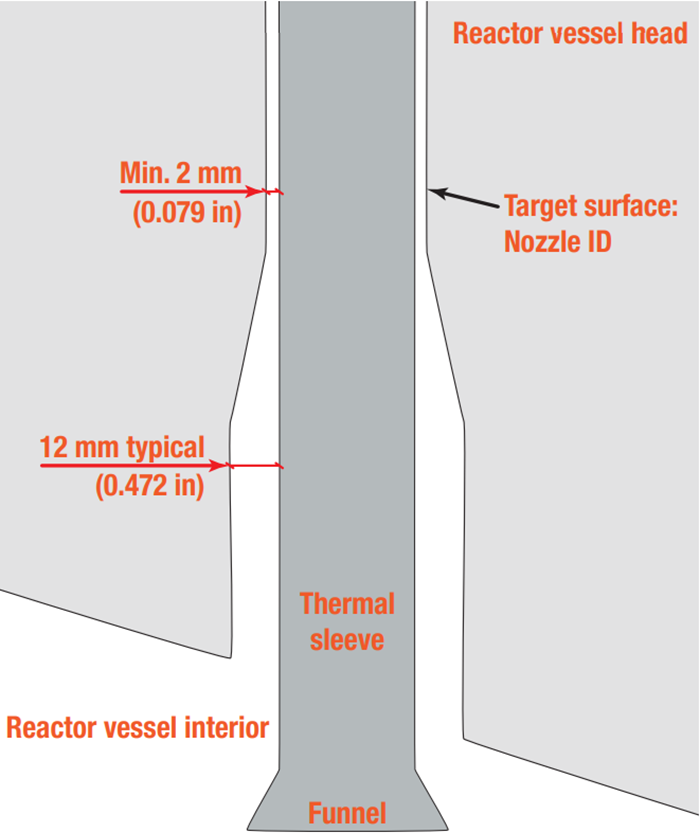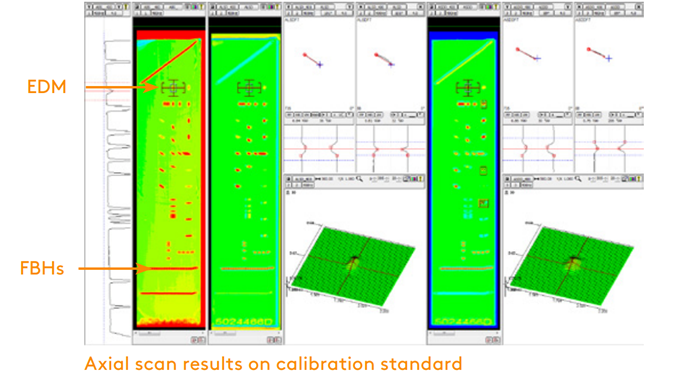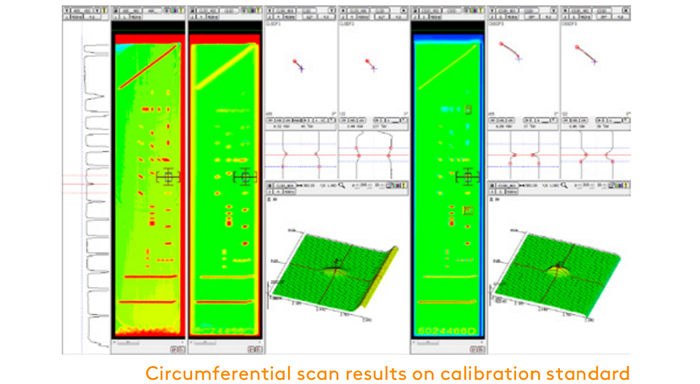Inspecting for Cracks in Tight Places
Control Rod Drive Mechanisms (CRDM) are located above nuclear reactor vessels. CRDMs insert, hold, or lift the control rods and are used to stop the nuclear reaction in the event of an emergency. They are therefore essential to the safe operation of nuclear power plants.
The Challenge
- Detect and characterize cracking in an inaccessible and limited space.
CRDM penetration nozzles that penetrate into the reactor vessel head are subject to various stresses, which can trigger axially oriented Inner-Diameter (ID) cracking. These flaws are typically surface breaking, 1.0–1.5 mm (0.039–0.059 in) deep, 5.0–5.2 mm (0.197–0.205 in) long, although some stress-corrosion and subsurface cracking may also occur in all orientations.
The only way this area can be inspected is from within the reactor vessel so, for obvious reasons, the inspection method must be robotized.
The penetration nozzle’s geometry poses a unique challenge that the current inspection method could not tackle. At the mouth of the nozzle, there is an interstice approximately 12 mm (0.472 in) wide between the nozzle’s ID and the thermal sleeve. However, the nozzle tapers around the sleeve, reducing this gap to a minimum of 2 mm (0.079 in). The current probe, while able to inspect the wider diameter, cannot fit into a 2 mm gap. The potential solution would have to adapt to this geometry variation. Reactor engineers must nevertheless inspect the penetration point’s ID for cracking.
The reactor vessel’s head and thermal sleeve are both made of austenitic alloys, which are corrosion and oxidation resistant, but the magnetic properties of these components pose yet another unique challenge for electromagnetic inspection. Because while cracks at the ID must be detected, the unwanted interference from the thermal sleeve must also be eliminated to leave only indications from at the ID.

The Solution
- A unique, ultra-thin shielded ECT probe capable of adapting to geometry changes.

The solution to this challenge is both simple and elegant. It finds its inspiration in nature: the flying squirrel.
As illustrated below, the probe’s head can collapse and expand around the thermal sleeve (like a flying squirrel’s wings) in such a way that the probe can fit in a space of 2 mm (0.079 in).
To achieve this while maintaining enough pressure on the probe’s head to keep contact with the nozzle’s ID constant, the probe’s head is made of finely machined technical thermoplastic. This material is extremely durable and yet flexible, which enable it to reshape itself and avoid using moving parts.
Inside the probe’s head, the ECT coils are shielded from the thermal sleeve’s interference by a highly conductive alloy that effectively produces clear signals from the nozzle’s ID.

Through an ingeniously designed setup file, the probe does not need a bulky external multiplexer to achieve four transmit-receive channels and one absolute channel, hence five topologies:
1- Axial long single drive: Detects axial defects.
2- Axial short dual driver: Detects small axial defects.
3- Circumferential long single driver: Detects circumferential defects.
4- Circumferential short single driver: Detects small axial defects.
5- An absolute channel is used to monitor liftoff.
Inspection results are rendered as Lissajous and C-scans for easy interpretation.
As demonstrated by the calibration results, the probe is capable of detecting an FBH 1.37 mm (0.054 in) in diameter and 1 mm (0.039 in) deep, as well as an EDM notch 5.08 mm (0.200 in) long, 0.10 mm (0.004 in) wide, 0.25 mm (0.010 in) deep at 0° with the axial topologies.
With the circumferential topologies, the probe is capable of detecting the same FBH and an EDM notch 5.16 mm (0.203 in) long, 0.10 mm (0.004 in) wide, 0.51 mm (0.020 in) deep at 90°.

Benefits
- Detecting cracks in previously uninspected inaccessible areas with high sensitivity.
The benefits of this probe are obvious:
Inspection of previously uninspected areas and increased security
The design adapts to the small available space to discover previously undetected defects.
More sensitivity and detail
More topologies yield more information and a higher level of details in scans, which enables detecting and sizing smaller defects.
Signal quality
The shielding in the probe head returns high-quality, interference-free indications.








